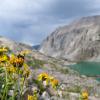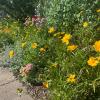Water sources are crucial for every habitat
Everyone needs water! This includes our favorite animals. Honey bees (Apis mellifera) and bumble bees (Bombus spp.) are familiar visitors to bird baths during warm weather, but they’re far from the only species that require access to a safe water source.
Adding a water feature to your yard, garden, or balcony can be an easy way to create much-needed habitat for many fascinating animals. All sorts of bees and beetles will stop by for a sip. Birds, of course, will cool off with a bath.

Some insects and amphibians will even spend most or all of their lives in a pond! For example, while dragonflies and damselflies, well, fly around as adults, they need water to reproduce. Adults lay their eggs in or near water, and most of their life is spent underwater in the aquatic immature stage, called a nymph or larva. Some bugs, like diving beetles, will happily stay in the water even as adults.
Any water feature, large or small, can make a big impact. Even a humble puddle can be an important habitat, especially to butterflies, who flock to the minerals and salts left on the surface of wet mud. These aquatic microhabitats form part of a larger network that supports biodiversity and provides refuges in urban landscapes.

How to build a water source for wildlife
First, scan your yard for places that bugs are already using as nests or shelter. These might include hollow stems, bare dirt, or brush piles of leaves or old wood. Or if you are working with a deck or balcony, simply alongside your plant pots. Then, choose a sunny place nearby to provide a shallow source of water. This might be a bird bath, or a bowl with stones on which bees and wasps can perch safely without slipping. To try attracting butterflies, you can add dirt to your basin and maintain a tasty mud puddle.
If you want to install a bigger water feature, like a pond, try to provide a sloping, or graduated, bank. Ponds or containers with vertical sides and no escape route run the risk of trapping and drowning wildlife like beetles, small mammals, and songbirds. With the right mix of features, your pond can become habitat for dragonflies and damselflies, who provide a dazzling aerial display.

Changing the water is enough to keep mosquitoes at bay
There’s one visitor you probably don’t want at your water source: mosquitoes. Pesticide sprays are not effective here. While they might kill a few adult mosquitoes, they also harm beneficial insects in your garden. Meanwhile, adult mosquitoes will fly in from elsewhere and new larvae will hatch.
Instead, for something like a bird bath, simply dump and refill the water every few days to keep it free of mosquito larvae. For permanent water bodies like ponds, add a fountain, waterfall, or small pump to keep the water moving, since mosquitoes can only reproduce in still water. If you use an open water pump, be sure to add protective screening. Otherwise, the pumps will pull dragonfly and damselfly nymphs in and kill them. These solutions are more effective and safer for wildlife than mosquito pesticides.
Watching wildlife at your water source
Once your water feature is installed, keep your eyes out for these tiny visitors:
- Mason bees (Osmia spp.) need mud to create their nests. In drier weather when mud is not available, they will frequently collect water in their crops and then carry it to the dirt in order to make their own mud.
- Paper wasps (Polistes spp.) are social nesters that also collect water to make paper and cool their colonies in hot weather.
- Digger bees (Anthophora spp.) also collect water in their crops, using it to soften the ground where they dig their nests. Some digger bee species make up to 80 water-collecting trips a day when excavating their nests.

Since many native bees and wasps will resort to collecting water from puddles and ditches when other sources are unavailable, they can run the risk of exposure to harmful pollutants and pesticides. Providing a shallow source of unpolluted water for bees and wasps can improve their overall chances of nesting successfully by reducing the time they need to forage, as well as their risk of exposure to pesticides.
Resources and further reading
- Tiny Places For Tiny Animals: Building The Microhabitats That Bugs Need To Thrive
- Backyard Ponds: Guidelines for Creating & Managing Habitat for Dragonflies and Damselflies
- Mosquito Management at Home
- Nesting & Overwintering Habitat for Pollinators & Other Beneficial Insects




